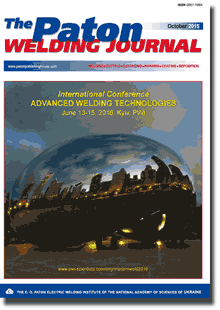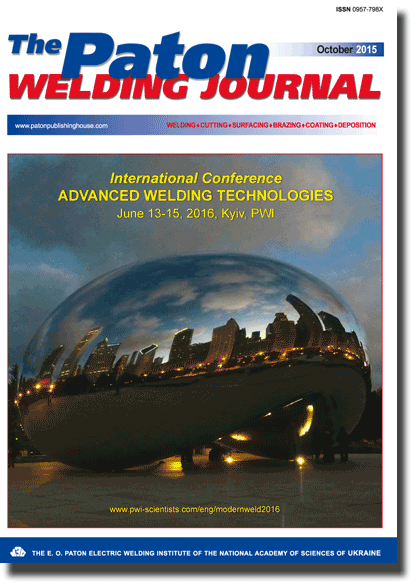| 2015 №10 (01) |
DOI of Article 10.15407/tpwj2015.10.02 |
2015 №10 (03) |

The Paton Welding Journal, 2015, #10, 10-18 pages
Modelling the characteristics of constricted-arc plasma in straight and reverse polarity air-plasma cutting
M.Yu. Kharlamov2, I.V. Krivtsun1, 2, V.N. Korzhik1, 2, V.I. Tkachuk2, V.E. Shevchenko1, 2, V.K. Yulyugin2, Wu Boyi1, A.I. Sitko2 And V.E. Yarosh2
1Chinese-Ukrainian E.O. Paton Welding Institute (Guangdong General Research Institute of Industrial Technology (Guangzhou Research Institute of Nonferrous Metals)) 363 Changxing Road, Tianhe, 510650, Guangzhou, China. E-mail: vnkorzhyk@gmail.com
2E.O. Paton Electric Welding Institute, NASU. 11 Bozhenko Str., 03680, Kiev, Ukraine. E-mail: office@paton.kiev.ua
Abstract
The paper deals with the issues of mathematical modelling of turbulent flow of electric arc plasma in straight and reverse polarity plasma cutting. It is noted that the main complexity of modelling reverse polarity cutting arises at description of plasma flow in near-electrode regions. In view of that, it is proposed to describe arc electromagnetic characteristics in the cut cavity proceeding from the known experimental data. Detailed comparative analysis of the influence of plasmatron operating modes and arc polarity on arc discharge electric characteristics, thermal and gas-dynamic characteristics of the plasma flow is performed on the base of numerical modelling. 17 Ref., 1 Table, 5 Figures.
Keywords: plasma cutting, straight and reverse polarity, electric arc plasma, turbulent flow, mathematical modelling, near-electrode regions, arc discharge electric characteristics
Received: 21.07.15
Published: 01.12.15
References
- Shirshov, I.G. (1987) Plasma cutting. Leningrad: Mashinostroenie.
- Kiselev, Yu.Ya. (2005) Investigation and development of technology and equipment for plasma-arc cutting of metals at reverse polarity: Syn. of Thesis for Dr. of Techn. Sci. Degree. Kishinev.
- Shchitsyn, V.Yu. (2005) Improvement of plasmatron structures and technologies of plasma treatment of metals at reverse polarity: Syn. of Thesis for Cand. of Techn. Sci. Degree. Perm.
- Engelsht, V.S., Asanov, D.S., Gurovich, V.Ts. et al. (1983) Mathematical modeling of electric arc. Frunze: Ilim.
- Borisov, Yu.S., Chernyshov, A.V., Krivtsun, I.V. et al. (1994) Computer-aided simulation and experimental study of dusted plasma jets emitting into limited space. In: Proc. of Nat. Thermal Spray Conf. (Boston, USA, 1994), 361-366.
- (1990) Theory of electric arc column. Ed. by M.F. Zhukov. Novosibirsk: Nauka.
- Favalli, R.C., Szente, R.N. (1998) Physical and mathematical modeling of non transferred plasma torches. Brazilian J. Physics, 1(March), 25-34. https://doi.org/10.1590/s0103-97331998000100004
- Kharlamov, M.Yu., Krivtsun, I.V., Korzhik, V.N. et al. (2007) Mathematical model of arc plasma generated by plasmatron with anode wire. The Paton Welding J., 12, 9-14.
- Kharlamov, M.Yu., Krivtsun, I.V., Korzhik, V.N. et al. (2009) Refined mathematical model of the electric arc burning in plasmatron with external current-conducting wire. Ibid., 1, 42-45.
- Lojtsyansky, L.G. (1973) Fluid and gas mechanics. Moscow: Nauka.
- Boulos, M.I., Fauchais, P., Pfender, E. (1994) Thermal plasmas: Fundamentals and applications. Vol. 1. N.Y.; London: Plenum Press. https://doi.org/10.1007/978-1-4899-1337-1
- Launder, B.E., Spalding, D.B. (1990) The numerical computation of turbulent flows. Computer Methods in Appl. Mechanics and Eng., 8, 269-289.
- Ievlev, V.M. (1975) Turbulent motion of high-temperature continua. Moscow: Nauka.
- Wilcox, D.C. (1994) Turbulence modeling for CFD. La Canada:. DCW Ind. Inc.
- Samarsky, A.A. (1971) Introduction to theory of difference schemes. Moscow: Nauka.
- Anderson, D., Tannehill, J., Pletcher, R. (1990) Computational fluid mechanics and heat transfer. Vol.1. Moscow: Mir.
- Paskonov, V.M., Polezhaev, V.I., Chudov, L.A. (1984) Numerical modeling of processes of heat-, mass transfer. Moscow: Nauka.
Suggested Citation
M.Yu. Kharlamov, I.V. Krivtsun, V.N. Korzhik, V.I. Tkachuk, V.E. Shevchenko, V.K. Yulyugin, Wu Boyi, A.I. Sitko and V.E. Yarosh (2015) Modelling the characteristics of constricted-arc plasma in straight and reverse polarity air-plasma cutting. The Paton Welding J., 10, 10-18.The cost of subscription/purchase order journals or individual articles
| Journal/Currency | Annual Set | 1 issue printed |
1 issue |
one article |
| TPWJ/USD | 384 $ | 32 $ | 26 $ | 13 $ |
| TPWJ/EUR | 348 € | 29 € | 24 € | 12 € |
| TPWJ/UAH | 7200 UAH | 600 UAH | 600 UAH | 280 UAH |
| AS/UAH | 1800 UAH | 300 UAH | 300 UAH | 150 UAH |
| AS/USD | 192 $ | 32 $ | 26 $ | 13 $ |
| AS/EUR | 180 € | 30 € | 25 € | 12 € |
| SEM/UAH | 1200 UAH | 300 UAH | 300 UAH | 150 UAH |
| SEM/USD | 128 $ | 32 $ | 26 $ | 13 $ |
| SEM/EUR | 120 € | 30 € | 25 € | 12 € |
| TDNK/UAH | 1200 UAH | 300 UAH | 300 UAH | 150 UAH |
| TDNK/USD | 128 $ | 32 $ | 26 $ | 13 $ |
| TDNK/EUR | 120 € | 30 € | 25 € | 15 € |
AS = «Automatic Welding» - 6 issues per year;
TPWJ = «PATON WELDING JOURNAL» - 12 issues per year;
SEM = «Electrometallurgy Today» - 4 issues per year;
TDNK = «Technical Diagnostics and Non-Destructive Testing» - 4 issues per year.


